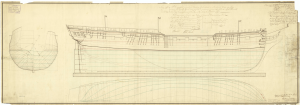 Plan used for the Diana
| |
| History | |
|---|---|
| Name | HMS Diana |
| Ordered | 28 March 1793 |
| Builder | Randall & Brent, Rotherhithe |
| Laid down | March 1793 |
| Launched | 3 March 1794 |
| Completed | 6 June 1794 |
| Out of service | Sold to the Dutch Navy on 7 March 1815 |
| Honours and awards | Naval General Service Medal with clasp "Egypt"[1] |
| Name | Diana |
| Acquired | Bought from the British on 7 March 1815 |
| Fate | Destroyed in dry-dock accident on 16 January 1839 |
| General characteristics | |
| Type | 38-gun Artois-class fifth-rate frigate |
| Tons burthen | 999 3⁄94 bm |
| Length |
|
| Beam | 39 ft 3+1⁄2 in (12.0 m) |
| Depth of hold | 13 ft 9 in (4.19 m) |
| Sail plan | Full-rigged ship |
| Complement | 270 (later 315) |
| Armament |
|
HMS Diana was a 38-gun Artois-class fifth-rate frigate of the Royal Navy. She was launched in 1794.
Sometime in late January or February, 1800 she recaptured the American schooner Sally and Mary that had been captured by a French privateer. The schooner was sent in to St. Kitts.[2] Because Diana served in the Royal Navy's Egyptian campaign between 8 March 1801 and 2 September, her officers and crew qualified for the clasp "Egypt" to the Naval General Service Medal that the Admiralty authorized in 1850 to all surviving claimants.[Note 1]
Diana participated in an attack on a French frigate squadron anchored at Saint-Vaast-la-Hougue at the action of 15 November 1810, which ultimately led to the destruction of the French frigate Elisa. (Boats from Diana went in and set fire to the beached Eliza despite heavy fire from shore batteries and three nearby armed brigs; the British suffered no casualties.[4])
In January or February 1812, the French captured Patent, Gillespie, master. Diana recaptured Patent on 4 February.[5] Patent arrived at Plymouth on 6 February.[6]

- ^ "No. 21077". The London Gazette. 15 March 1850. pp. 791–792.
- ^ "Naval Documents related to the Quasi-War Between the United States and France Volume Part 1 of 4 Naval Operations January to May, 1800, Front Matter January Pg. 133" (PDF). U.S. Government printing office via Imbiblio. Retrieved 7 June 2024.
- ^ "No. 17915". The London Gazette. 3 April 1823. p. 633.
- ^ "No. 16438". The London Gazette. 25 December 1810. p. 2061.
- ^ "No. 16598". The London Gazette. 28 April 1812. p. 813.
- ^ "The Marine List". Lloyd's List. No. 4638. 11 February 1812. hdl:2027/uc1.c2735025. Retrieved 7 October 2020.
Cite error: There are <ref group=Note> tags on this page, but the references will not show without a {{reflist|group=Note}} template (see the help page).